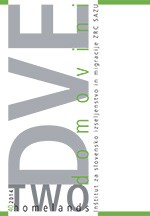Female Immigration and Employment in Trieste at the Turn of the 19th and 20th Centuries
Keywords:
female migrations, female employment, Trieste, urbanization, urban historyAbstract
The article examines female immigration and employment in Trieste on the basis of census statistics. It starts by illustrating the geographic origin of the immigration flows and the factors that influenced their volumes, dynamics and sex ratio. Then the employment of women is presented, which was mainly cor- related with young age and single marital status and was concentrated in two principal sectors: crafts and domestic services. In the third part the article analyses the geographical origin of the economi- cally active female population, their inclusion in the labour market and their distribution by working segments. We found that the native women tended to be employed in craft activities, while domestic services were the dominion of immigrant women. This separation is correlated with the specificities of the working sectors, the different social status and the aspirations of native and immigrant women. We also discuss certain aspects of female migration and the reliability of the statistics concerning the involvement of women in economic activities.
Downloads
References
Bade, Klaus (2005). Evropa v gibanju: Migracije od poznega 18. stoletja do danes. Ljubljana: Založba /*cf.
Cattaruzza, Marina (1979). La formazione del proletariato urbano: Immigrati, operai di mestiere, donne a Trieste dalla metà del secolo XIX alla prima guerra mondiale. Torino: Musolini editore.
Dorsi, Pier Paolo (1996). I »regnicoli«: Una componente dimenticata della società triestina in età asburgica. Trieste, Austria, Italia tra Settecento e Novecento: Studi in onore a Elio Apih (ur. Marina Cattaruzza). Udine: Del Bianco, 113−130.
Dukovski, Darko (2012). Habsburški popisi stanovništva kao izvor podataka za društvenu i ekonomsku povijest: Procesi modernizacije u Istri – usporedne statistike Kopra i Pule. Prvi moderni popis stanovništva u Istri – Il primo censimento demografico moderno in Istria – Prvi moderni popis prebivalstva v Istri (ur. Aleksej Kalc). Koper/Capodistria: Histria Editiones, 333−356.
Finzi, Roberto, Panariti, Loredana, Panjek, Giovanni (ur.) (2003). Storia economica e sociale di Trieste. La città dei traffici: 1719−1918. Trieste: Lint.
Frühbauer, Attilio (1906). Censimento della popolazione a Trieste al 31 dicembre 1900: Età, stato civile, professione o condizione, immigrazione. Trieste: Il Municipio Di Trieste Editore.
Gribaudi, Maurizio (1987). Itinéraires ouvriers: Espaces et groupes sociaux au début du XXe siècle. Paris: Éditions de l’EHESS.
Groppi, Angela (1996). Lavoro e proprietà delle donne in età moderna. Il lavoro delle donne (ur. Angela Groppi). Roma, Bari: Laterza, 119−163.
Hahn, Sylvia (2001). Nowhere at Home? Female Migrants in the Nineteenth Century Habsburg Empire. Women, Gender and Labour Migration, Historical and Global Perspectives (ur. Pamela Sharpe). London, New York: Routledge, 108–126.
Hahn, Sylvia (2012). Historische Migrationsforschung. Frankfurt, New York: Campus Verlag.
Jakomin, Dušan (1987). Škedenjska krušarca − Servola: La portatrice di pane. Trst: Dom Jakoba Ukmarja.
Kalc, Aleksej (2008). Tržaško prebivalstvo v 18. stoletju. Koper: Knjižnica Annales.
Kalc, Aleksej (2013). Vidiki razvoja prebivalstva Goriško-Gradiške v 19. stoletju in do prve svetovne vojne. Acta Histriae 21/4, 1−24.
Kocka, Jürgen, Haupt, Heinz-Gerhard (1996). Vecchie e nuove classi nell’Europa del XIX secolo. Storia d’Europa: 5: L’età contemporanea, secoli XIX−XX (ur. Paul Bairoch, Erik J. Hobsbawm). Torino: Einaudi, 675−750.
La popolazione (1878). La popolazione di Trieste nel 1875: Resoconto ufficiale del censimento generale della popolazione effettuato secondo lo stato del 31 dicembre 1875. Trieste: Civico Ufficio Statistico Anagrafico.
Lazzarini, Antonio (1981). Campagne venete ed emigrazione di massa (1866−1900). Vicenza: Istituto per le ricerche di storia sociale e di storia religiosa.
Ledinek Lozej, Špela, Rogelja, Nataša (2012). Šavrinka, Šavrini in Šavrinija v etnografiji in literaturi = The Šavrinka, Šavrin, and Šavrinija in Ethnography and Literature. Slavistična revija 60/3, 537–560.
Micelli, Francesco (1991): L’emigrazione dal »Friuli orientale«. Economia e società nel Goriziano tra ‘800 e ‘900: Il ruolo della Camera di Commercio (1850−1915 (ur. Furio Bianco, Maria Masau Dan). Monfalcone: Edizioni della Laguna, 173−190.
Milharčič Hladnik, Mirjam (2009). Ustna zgodovina Luise Passerini in raziskovanje migracij v kontekstu subjektivnosti. Dve domovini / Two Homelands 29, 93–101.
Milharčič Hladnik, Mirjam (2014). Pomen biografske metode za re-kreacijo spomina na ženske delovne migracije iz Goriške. Dve domovini / Two Homelands 40.
Österreichische Statistik (1882−1914): Ergebnisse der Volkszählungen etc., Band XXXII, Heft 1, 2, 5 (1890); Band LXIII, Heft 1, 2; Band LXIV, Heft 1, 2 (1900); Band 1 Neue Folge, Heft 1, 2; Band 2 Neue Folge, Heft 1 (1910). Dunaj: K. k. Statistische Central-Commission.
Page Moch, Leslie (1992). Moving Europeans: Migration in Western Europe since 1650. Bloomington, Indianapolis: Indiana Universiry Press.
Pescarolo, Alessandra (1996). Il lavoro e le risorse delle donne in età contemporanea. Il lavoro delle donne (ur. Angela Groppi). Roma, Bari: Laterza, 299−344.
Ramella, Franco (2008). Variazioni sul tema delle donne nelle migrazioni interne. Donne e uomini migranti (ur. Angiolina Arru, Daniela Caglioti, Franco Ramella). Roma: Donzelli, 108−144.
Repinc, Martina (1990). Perice v vaseh tržaškega Brega (od 1918 do zatona obrti). Diplomska naloga, Univerza v Ljubljani.
Rosental, Paul-André (1999). Les sentiers invisibles: Espaces, familles et migrations dans la France du XIXe siècle. Paris: Éditions de l’EHESS.
Steidl, Annemarie (2009). Introduction. European mobility. Internal, international, and transatlantic moves in the 19th and early 20th centuries (ur. Annemarie Steidl, Josef Ehmer, Stan Nadel, Hermann Zeitlhofer). Göttingen: V & R unipress, 7−16.
Downloads
Published
How to Cite
Issue
Section
License

This work is licensed under a Creative Commons Attribution-NonCommercial-NoDerivatives 4.0 International License.
Authors guarantee that the work is their own original creation and does not infringe any statutory or common-law copyright or any proprietary right of any third party. In case of claims by third parties, authors commit their self to defend the interests of the publisher, and shall cover any potential costs.
More in: Submission chapter





